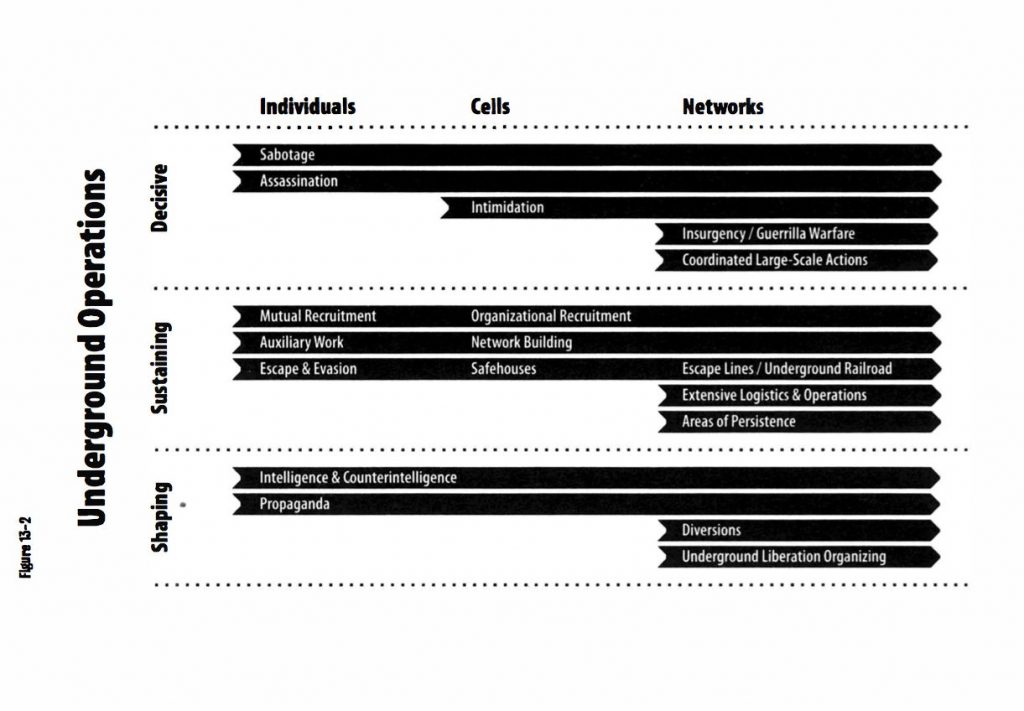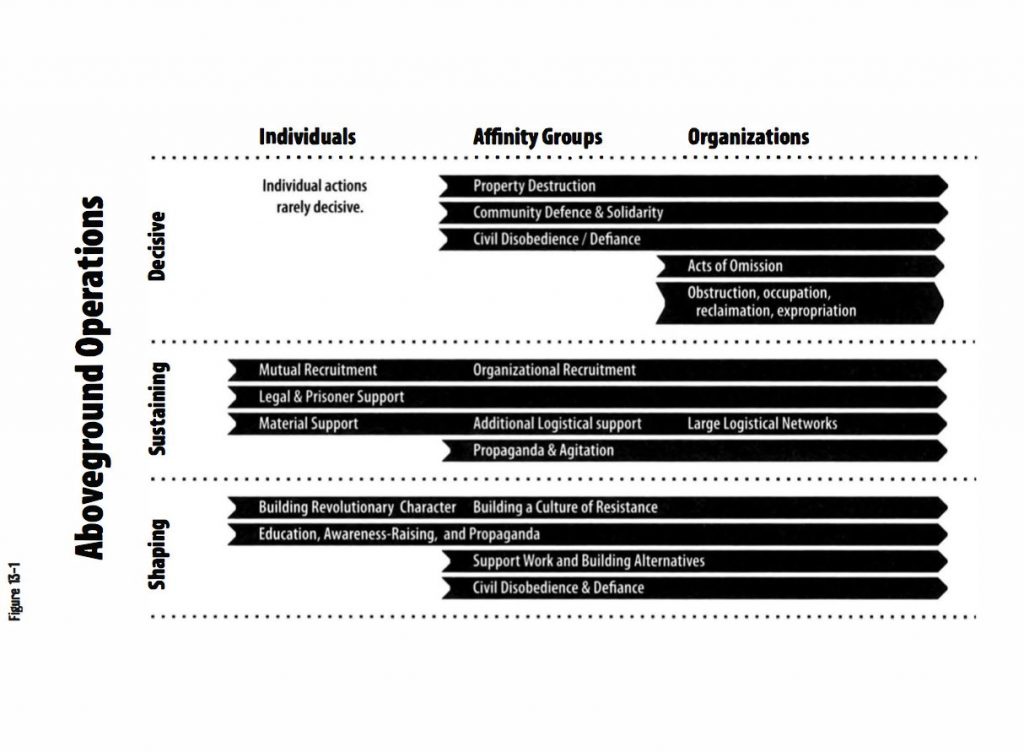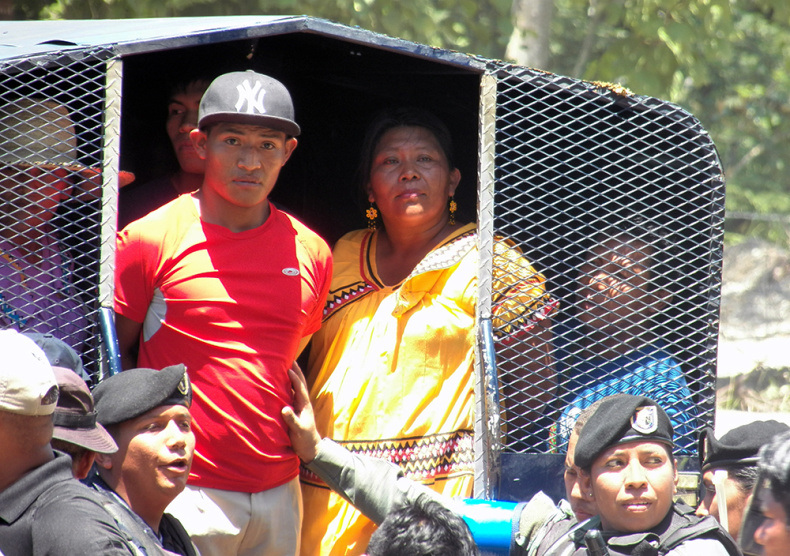
by DGR Colorado Plateau | Aug 6, 2015 | Colonialism & Conquest, Indigenous Autonomy, Obstruction & Occupation
By Richard Arghiris / Intercontinental Cry
Protests against the Barro Blanco hydro dam in western Panama turned violent last Saturday, July 25, when riot police, claiming to act in self-defense, unleashed pepper spray and batons on some 50 Ngäbe activists, women and children among them. At least three protesters were badly injured in the clash.
The crackdown occurred during a visit to the area by the Panamanian Vice President Isabel Saint Malo, who, under the pretext of dialogue, convened three Ngäbe leaders behind closed doors at the Centro Misionero (Mission Centre) in the town of Tolé. Despite a reasonable request to be included in the meeting, leaders from local community groups were excluded. Activists responded to Saint Malo’s move by blockading the Carretera Interamericana, the country’s principle highway.
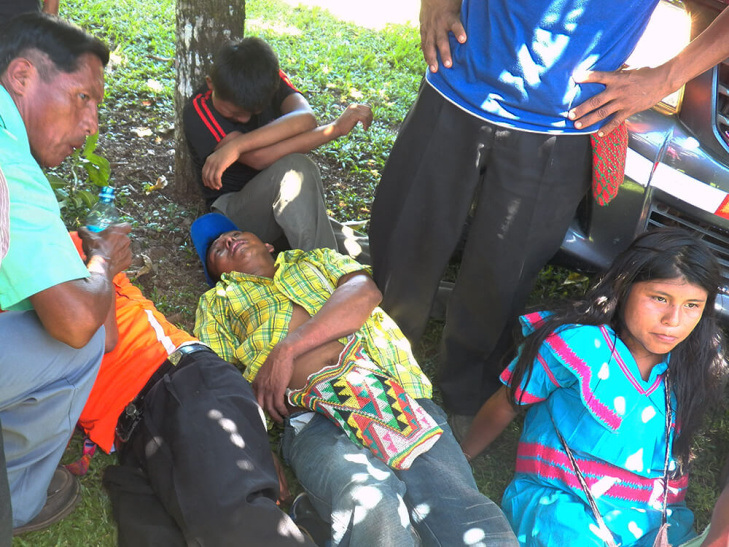
Protesters, including women and children, recover after clashes with the police. (Photo: Oscar Sogandares)
According to the Ngäbe, at around 10:15 am, in scenes reminiscent of the Martinelli years, the police reacted violently to disperse the 50-strong protesters, destroying their equipment, trashing their camps, and burning their banners.
The police deny improper use of force.
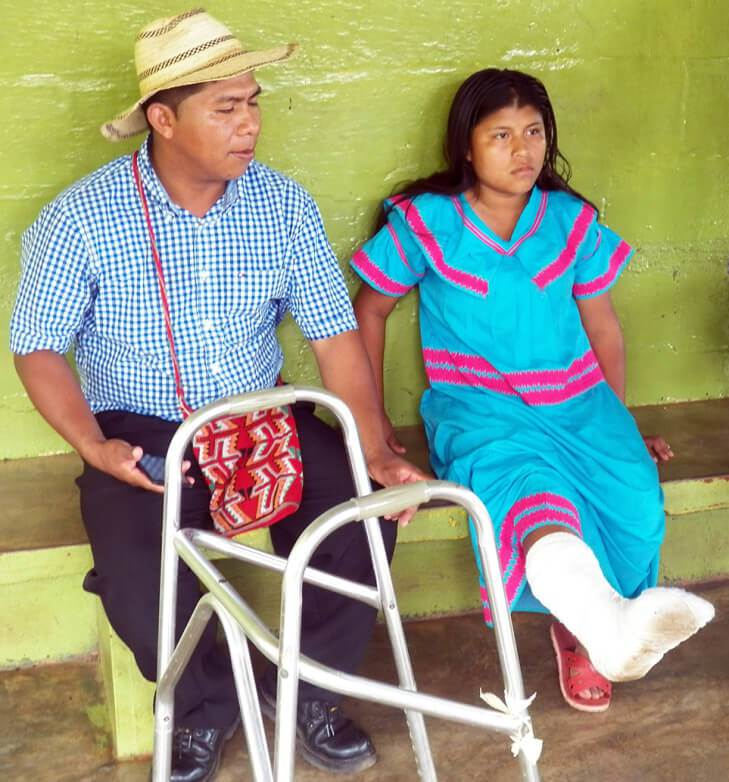
Edilma Pinto, 17, suffered a fractured foot during the police crackdown. (Photo: Oscar Sogandares)
Many fled the scene before 20 people were arrested (including several minors) and dispatched to the city of Santiago for processing.
While in the private meeting with Saint Malo, the Cacique of Muná, Chito Gallardo, and the Mayor of Muná, Rolando Carpintero, learned of the arrests and quickly intervened to have them returned. The injured were soon taken to the Casa Misionero for treatment and for the Vice President to bear witness.
According to one person at the scene, the vice president appeared coolly uninterested.
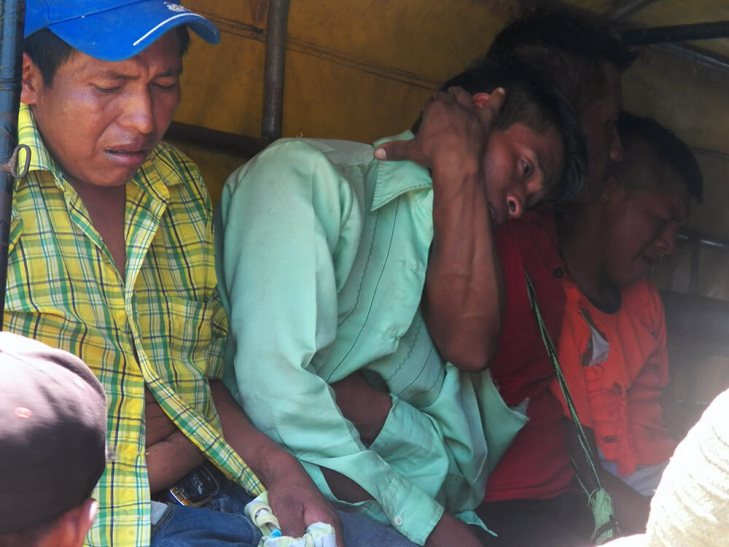
Some 20 Ngäbe protesters were detained by the police. (Photo: Oscar Sogandares)
For several weeks, hundreds of police units have been stationed in and around Tolé, including numerous SENAFRONT troops, an elite militarized squad funded in part by the United States. SENAFRONT is normally charged with defending the jungle frontier with Colombia, making their presence of considerable significance.
Under the US Leahy Law on Human Rights, the US Department of State is prohibited from providing military assistance to foreign units who violate human rights with impunity.
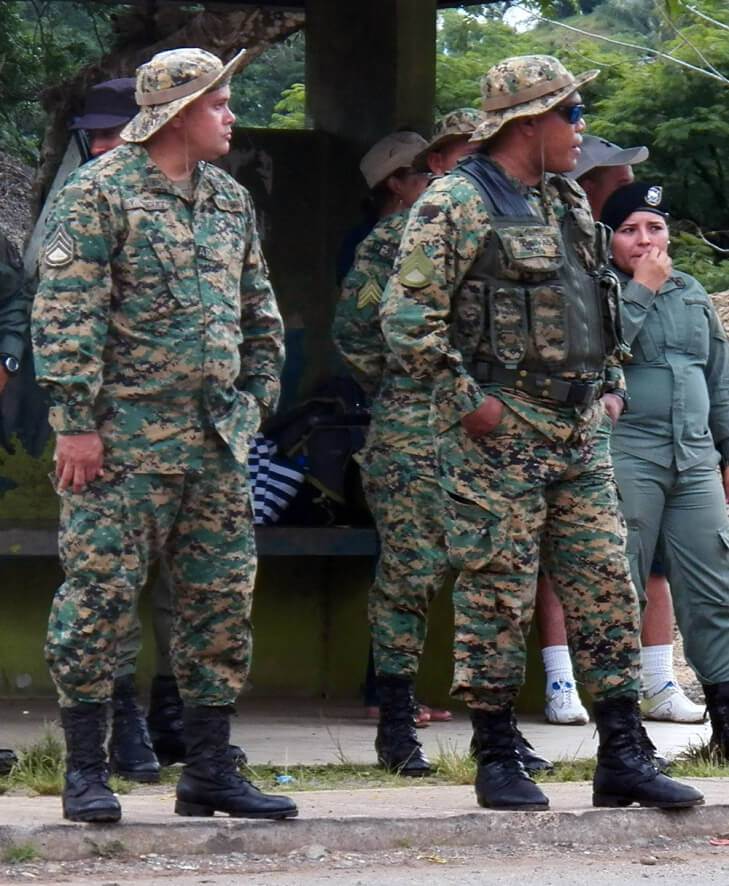
Partly funded by the US State Department, elite SENAFRONT troops have been dispatched to the area. (Photo: Oscar Sogandares)
The clashes on the Interamericana foreshadow greater unrest as Barro Blanco’s owner, Generadora del Istmo (GENISA) – a corporation owned by the controversial Kafie family, now mired in a high-level corruption scandal in Honduras – scrambles to complete the final 5-10% of the hydro dam’s construction.
The company has never sought the free, informed, and prior consent of the indigenous communities living on the banks of the Tabasará river, while the project’s funders, the Dutch and German investment banks FMO and DFE, admit to failing their own due diligence tests. Unfortunately, all funds have now been dispensed to GENISA and the banks themselves made a point of threatening the government when it suspended the project earlier this year.
The negative impacts of Barro Blanco have been identified by scores of technical teams, independent experts, international observers, and the United Nations. Those same impacts are nowhere to be found in GENISA’s Environmental Impact Assessment. Among them, the dam will displace several indigenous and campesino communities, including the community of Kiad, where a unique school and cultural centre is developing the written script of the Ngäbere language.
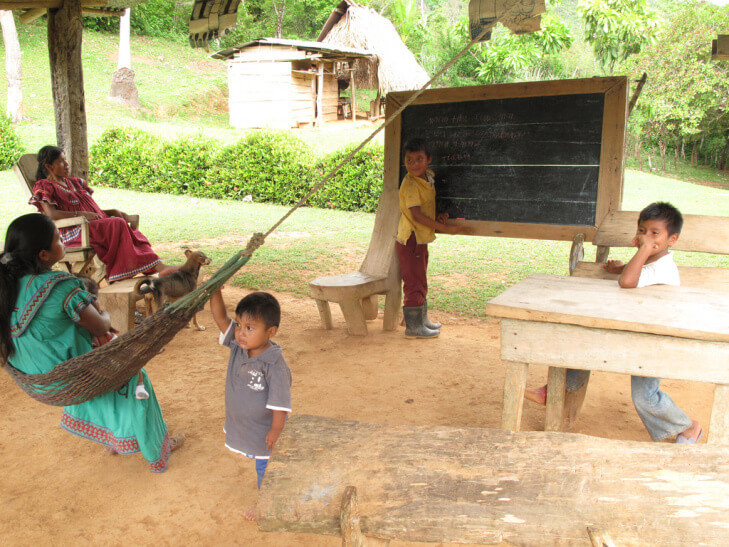
The ancient Ngabere language is taught at this school house in Kiad. (Photo: Richard Arghiris)
Additional impacts include the loss of farm plots and fish stocks — vital sources of sustenance for indigenous and campesino communities in the region – as well as the loss of several ancient petroglyphs, part of Panama’s national patrimony and a special significance to the Mama Tata religion, a Ngäbe revivalist movement that syncretises indigenous animism and Catholicism.
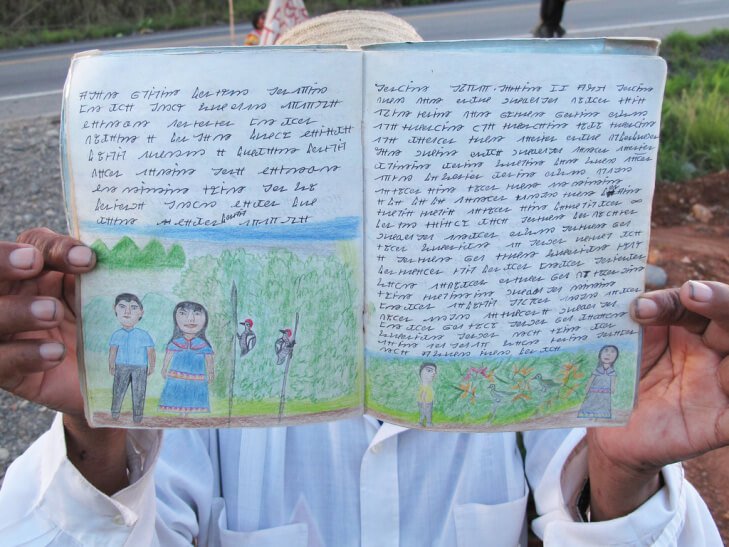
The Ngabere language is a great source of cultural pride. (Photo: Richard Arghiris)
Among the most devout followers of Mama Tata are the M22 resistance movement, who successfully blockaded the entrance to the dam for 38 consecutive days – until just ten days ago. International news footage of the groups praying and dancing on the highway may have influenced the government’s decision to enforce a ‘soft’ take-over of the site entrance. In contrast to the force deployed outside Tolé, Ngäbe women lying in the path of machinery were carefully removed.
Construction of the dam has now resumed and M22 are continuing to pray day and night by the highway. They complain of psychological intimidation with the police shining high intensity lamps on their camp during the night and aggressively entering the temple they have built near the river banks.
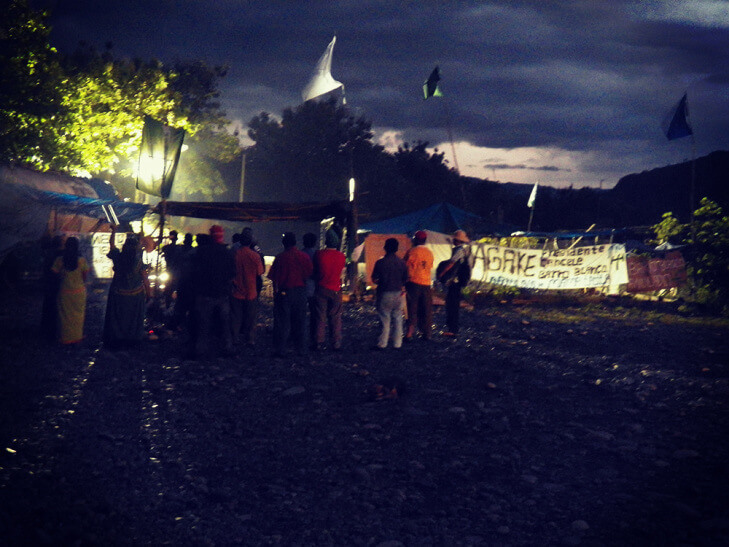
Days before their eviction from the site entrance, M22 gather for prayers under police spotlights. (Photo: Oscar Sogandares)
For his part, Panamanian President Varela, who continues to talk condescendingly about giving the Ngäbe ‘the keys to the dam’ upon its completion, appears to have acquiesced to pressures from his own business community, tacitly enabling foreign corporations who respect neither the environment nor international law nor indigenous or human rights.
The Supreme Court has cheered him on by annulling a moratorium on hydro projects passed by the environment agency, ANAM, who were concerned with the stress being placed on Panama’s delicate but biologically rich watersheds. With the crackdown last week, the Panamanian government appears officially back to business as usual.
From Intercontinental Cry: https://intercontinentalcry.org/barro-blanco-protesters-injured-and-arrested-28467/#imageclose-28472
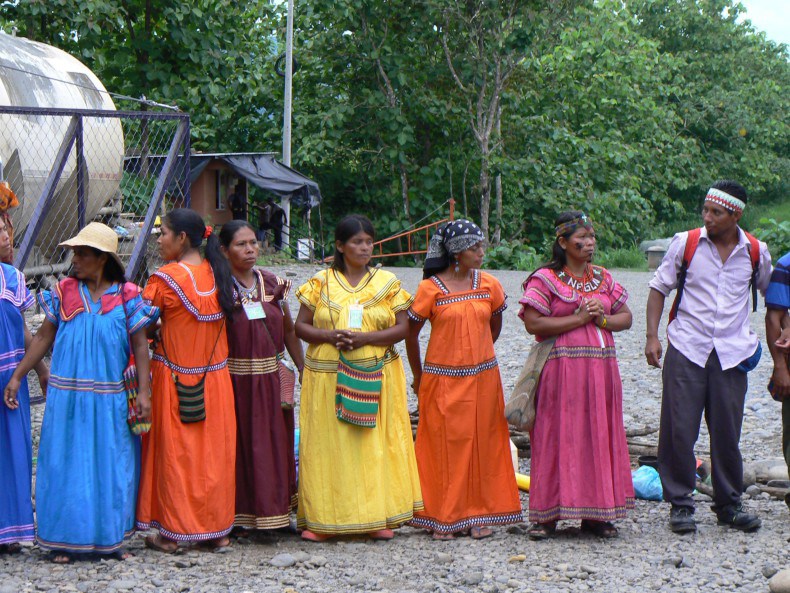
by DGR Colorado Plateau | Aug 5, 2015 | Biodiversity & Habitat Destruction, Colonialism & Conquest, Indigenous Autonomy, Obstruction & Occupation
By Richard Arghiris and Jennifer Kennedy / Intercontinental Cry
June 14, 2015
NGÄBE ISSUE ULTIMATUM TO THE GOVERNMENT OF PANAMA: CANCEL THE PROJECT BY MONDAY
A 30-strong splinter group of Ngäbe from the M10 resistance movement has blocked the entrance to the Barro Blanco hydroelectric dam in western Panama, preventing workers from entering the site. The 15 year struggle of the Tabasará river communities to protect their livelihoods, their culture, and their ancestral heritage now appears to be entering a tense new phase. With negotiations exhausted and the dam 95% complete, M10 has an issued an ultimatum for the government to cancel the project by Monday, June 15, 2015. It is unclear how the government will respond.
“Being Ngäbe-Buglé cultural patrimony,” said Clementina Pérez, part of the group camped at Barro Blanco’s gates. “Our river, our mother earth, our ecology, our existence, we are here to make known to the national and international community that this patrimony belongs to us and to the church of Mama Tata. With the conservation of peace, liberty, justice and unity, liberation and social justice… [we ask] the President of the Republic the cancellation and removal of the dam from our communities, our river and our mother earth, which belong to us as original people of the Americas…”
Funded by European banks – the German Investment Corporation (DEG) and the Dutch Development Bank (FMO) – the dam is set to inundate a string of Ngäbe and campesino communities, all of whom have voiced their objections from the outset. The flood will destroy ancestral petroglyphs, fertile agricultural grounds, and Mama Tata cultural centres, including a unique school where the emerging written script of the Ngäbere language is being developed and disseminated. The dam will significantly impact the river’s marine life, wiping out migratory fish species which many communities – both up and down stream – rely upon for essential protein. None of the Tabasará communities have provided their free, informed and prior consent to the dam, a fact recently confirmed by the FMO’s own independent complaints mechanism (ICM).
“Lenders should have sought greater clarity on whether there was consent to the project from the appropriate indigenous authorities prior to project approval,” said an ICM report, published on May 29, 2015. “[The plan] contains no provision on land acquisition and resettlement and nothing on biodiversity and natural resources management. Neither does it contain any reference to issues related to cultural heritage…”
The report is the latest in a series of professional analyses that pour a thick layer of scorn over the dam project’s owner, Generadora del Istmo (GENISA). Demonstrably unlawful, GENISA has been condemned by numerous independent investigators, the United Nations, several international NGOs, and Panama’s own environmental agency, ANAM, who found a raft of flaws and short-comings in their environmental impact assessment.
But despite failing their own due diligence, the banks appear to have shrugged off the ICM report with an insipid call for “constructive dialogue” and “a solution for a way forward.” In February this year, the FMO chose to threaten the government of Panama after building work was temporarily suspended on the recommendation of ANAM. Writing to the Vice President, the FMO warned that the suspension “May weigh upon future investment decisions, and harm the flow of long-term investments into Panama.”
The government seems to have taken this threat to heart. Panama’s president, Juan Carlos Varela, who was elected to office in 2014, flip-flopped on Barro Blanco before finally falling in line. Last week, while proffering flimsy reassurances about having found a human rights solution, his government left the negotiating table and signaled an end to the suspension of works. M10 claims the work never stopped and has been continuing clandestinely. They are now mobilizing for action.
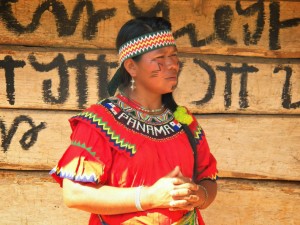
Clementina Perez (Photo: Oscar Sogandares)
“If this situation is not resolved,” said Clementina Pérez, “We will go to the Panamerican highway to ask together, at a national level, the cancellation of Barro Blanco…”
Rising with stark grey walls above the denuded banks of the Tabasará, Barro Blanco has become a symbol of the previous administration, its fundamental violence and contempt for the rule of law. The former President Ricardo Martinelli – now on the run in the United States and facing a corruption probe back home – provoked no less than four major uprisings as he grasped for land and resources in Panama’s indigenous territories. Heavy-handed repression resulted in the deaths of several protesters and bystanders, including an unarmed teenage boy who was shot in the face by police. Barro Blanco is the visible legacy of a proudly thuggish President who serially abused Panama’s Indigenous Peoples and plundered the country at will. Thus far, Varela has been keen to strike a more decent and humane tone. How he now handles the crisis evolving on the banks of the Tabasará River will be a demonstration of his sincerity, or lack of.
From Intercontinental Cry: https://intercontinentalcry.org/ngabe-block-entry-to-barro-blanco-hydro-dam-panama-28186/
by DGR Colorado Plateau | Jun 22, 2015 | Building Alternatives, Gender, Strategy & Analysis
In 1993 Michael Carter was arrested and indicted for underground environmental activism. Since then he’s worked aboveground, fighting timber sales and oil and gas leasing, protecting endangered species, and more. Today, he’s a member of Deep Green Resistance Colorado Plateau, and author of the memoir Kingfishers’ Song: Memories Against Civilization.
Time is Short spoke with him about his actions, underground resistance, and the prospects and problems facing the environmental movement. The first part of this interview is available here, and the second part here.
Time is Short: You mentioned some problems of radical groups—lack of respect for women and lack of a strategy. Could you expand on that?
Michael Carter: Sure. To begin with, I think both of those issues arise from a lifetime of privilege in the dominant culture. Men in particular seem prone to nihilism; I certainly was. Since we were taught—however unwittingly—that men are entitled to more of everything than women, our tendency is to bring this to all our endeavors.
I will give some credit to the movie “Night Moves” for illustrating that. The men cajole the woman into taking outlandish risks and they get off on the destruction, and that’s all they really do. When an innocent bystander is killed by their action, the woman has an emotional breakdown. She’s angry with the men because they told her no one would get hurt, and she breaches security by talking to other people about it. Their cell unravels and they don’t even explore their next options together. Instead of providing or even offering support, one of the men stalks and ultimately kills the woman to protect himself from getting caught, then vanishes back into mainstream consumer culture. So he’s not only a murderer but ultimately a cowardly hypocrite, as well.
Honestly, it appears to be more of an anti-underground propaganda piece than anything. Or maybe it’s just a vapid film, but it does have one somewhat valid point—that we white Americans, particularly men, are an overprivileged self-centered lot who won’t hesitate to hurt anyone who threatens us.
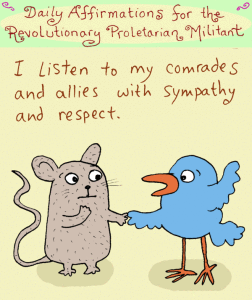
Artwork by Stephanie McMillan
That’s a fictional example, but any female activist can tell you the same thing. And of course misogyny isn’t limited to underground or militant groups; I saw all sorts of male self-indulgence and superiority in aboveground circles, moderate and radical both. It took hindsight for me to recognize it, even in myself. That’s a central problem of radical environmentalism, one reason why it’s been so ineffective. Why should any woman invest her time and energy in an immature movement that holds her in such low regard? I’ve heard this complaint about Occupy groups, anarchists, aboveground direct action groups, you name it.
Groups can overcome that by putting women in positions of leadership and creating secure, uncompromised spaces for them to do their work. I like to reflect on the multi-cultural resistance to the Burmese military dictatorship, which is also a good example of a combined above- and underground effort, of militant and non-violent tactics. The indigenous people of Burma traditionally held women in positions of respect within their cultures, so they had an advantage in building that into their resistance movements, but there’s no reason we couldn’t imitate that anywhere. Moreover, if there are going to be sustainable and just cultures in the future, women are going to be playing critical roles in forming and running them, so men should be doing everything possible to advocate for their absolute human rights.
As for strategy, it’s a waste of risk-taking for someone to cut down billboards or burn the paint off bulldozers. It’s important not to equate willingness with strategy, or radicalism and militancy with intelligence. For example, I just noticed an oil exploration subcontractor has opened an office in my town. Bad news, right? I had a fleeting wish to smash their windows, maybe burn the place down. That’ll teach ‘em, they’ll take us seriously then. But it wouldn’t do anything, only net the company an insurance settlement they’d rebuild with and reinforce the image of militant activists as mindless, dangerous thugs.
If I were underground, I’d at least take the time to choose a much more costly and hard-to-replace target. I’d do everything I could to coordinate an attack that would make it harder for the company to recover and continue doing business. And I’d only do these things after I had a better understanding of the industry and its overall effects, and a wider-focused examination of how that industry falls into the mechanism of civilization itself.
By widening the scope further, you see that ending oil and gas development might better be approached from an aboveground stance—by community rights initiatives, for example, that have outlawed fracking from New York to Texas to California. That seems to stand a much better chance of being effective, and can be part of a still wider strategy to end fossil fuel extraction altogether, which would also require militant tactics. You have to make room for everything, any tactic that has a chance of working, and begin your evaluation there.
To use the Oak Flat copper mine example, now the mine is that much closer to happening, and the people working against it have to reappraise what they have available. That particular issue involves indigenous sacred sites, so how might that be respectfully addressed, and employed in fighting the mine aboveground? Might there be enough people to stop it with civil disobedience? Is there any legal recourse? If there isn’t, how might an underground cell appraise it? Are there any transportation bottlenecks to target, any uniquely expensive equipment? How does timing fit in? How about market conditions—hit them when copper prices are down, maybe? Target the parent company or its other subsidiaries? What are the company’s financial resources?
An underground needs a strategy for long-term success and a decision-making mechanism that evaluates other actions. Then they can make more tightly focused decisions about tactics, abilities, resources, timing, and coordinated effort. The French Resistance to the Nazis couldn’t invade Berlin, but they sure could dynamite train tracks. You wouldn’t want to sabotage the first bulldozer you came across in the woods; you’d want to know who it belonged to, if it mattered, and that you weren’t going to get caught. Maybe it belongs to a habitat restoration group, who can say? It doesn’t do any good to put a small logging contractor out of business, and it doesn’t hurt a big corporation to destroy machinery that is inexpensive, so those questions need to be answered beforehand. I think successful underground strikes must be mostly about planning; they should never, never be about impulse.
TS: There are a lot of folks out there who support the use of underground action and sabotage in defense of Earth, but for any number of reasons—family commitments, physical limitations, and so on—can’t undertake that kind of action themselves. What do you think they can do to support those willing and able to engage in militant action?
MC: Aboveground people need to advocate underground action, so those who are able to be underground have some sort of political platform. Not to promote the IRA or its tactics (like bombing nightclubs), but its political wing of Sinn Fein is a good example. I’ve heard a lot of objections to the idea of advocating but not participating in underground actions, that there’s some kind of “do as I say, not as I do” hypocrisy in it, but that reflects a misunderstanding of resistance movements, or the requirements of militancy in general. Any on-the-ground combatant needs backup; it’s just the way it is. And remember that being aboveground doesn’t guarantee you any safety. In fact, if the movement becomes effective, it’s the aboveground people most vulnerable to harm, because they’re going to be well known. In that sense, it’s safer to be underground. Think of the all the outspoken people branded as intellectuals and rounded up by the Nazis.
The next most important support is financial and material, so they can have some security if they’re arrested. When environmentalists were fighting logging in Clayoquot Sound on Vancouver Island in the 1990s, Paul Watson (of the Sea Shepherd Conservation Society) offered to pay the legal defense of anyone caught tree spiking. Legal defense funds and on-call pro-bono lawyers come immediately to mind, but I’m sure that could be expanded upon. Knowing that someone is going to help if something horrible happens, combatants can take more initiative, can be more able to engineer effective actions.
We hope there won’t be any prisoners, but if there are, they must be supported too. They can’t just be forgotten after a month. As I mentioned before, even getting letters in jail is a huge morale booster. If prisoners have families, it’s going to make a big difference for them to know that their loved ones aren’t alone and that they will have some sort of aboveground material support. This is part of what we mean when we talk about a culture of resistance.
TS: You’ve participated in a wide range of actions, spanning the spectrum from traditional legal appeals to sabotage. With this unique perspective, what do you see as being the most promising strategy for the environmental movement?
MC: We need more of everything, more of whatever we can assemble. There’s no denying that a lot of perfectly legal mainstream tactics can work well. We can’t litigate our way to sustainability any more than we can sabotage our way to sustainability; but for the people who are able to sue the enemy, that’s what they should be doing. Those who don’t have access to the courts (which is most everyone) need to find other roles. An effective movement will be a well-organized movement, willing to confront power, knowing that everything is at stake.
Decisive Ecological Warfare is the only global strategy that I know of. It lays out clear goals and ways of arranging above- and underground groups based on historical examples of effective movements. If would-be activists are feeling unsure, this might be a way for them to get started, but I’m sure other plans can emerge with time and experience. DEW is just a starting point.
Remember the hardest times are in the beginning, when you’re making inevitable mistakes and going through abrupt learning curves. When I first joined Deep Green Resistance, I was very uneasy about it because I still felt burned out from the ‘90s struggles. What I’ve discovered is that real strength and endurance is founded in humility and respect. I’ve learned a lot from others in the group, some of whom are half my age and younger, and that’s a humbling experience. I never really understood what a struggle it is for women, either, in radical movements or the culture at large; my time in DGR has brought that into focus.
Look at the trans controversy; here are males asking to subordinate women’s experiences and safe spaces so they can feel comfortable. It’s hard for civilized men to imagine relationships that aren’t based on the dominant-submissive model of civilization, and I think that’s what the issue is really about—not phobia, not exclusionary politics, but rather role-playing that’s all about identity. Male strength traditionally comes from arrogance and false pride, which naturally leads to insecurity, fear, and a need to constantly assert an upper hand, a need to be right. A much more secure stance is to recognize the power of the earth, and allow ourselves to serve that power, not to pretend to understand or control it.
 TS: We agree that time is not on our side. What do you think is on our side?
TS: We agree that time is not on our side. What do you think is on our side?
MC: Three things: first, the planet wants to live. It wants biological diversity, abundance, and above all topsoil, and that’s what will provide any basis for life in the future. I think humans want to live, too; and more than just live, but be satisfied in living well. Civilization offers only a sorry substitute for living well to only a small minority.
The second is that activists now have a distinct advantage in that it’s easier to get information anonymously. The more that can be safely done with computers, including attacking computer systems, the better—but even if it’s just finding out whose machinery is where, how industrial systems are built and laid out, that’s much easier to come by. On the other hand the enemy has a similar advantage in surveillance and investigation, so security is more crucial than ever.
The third is that the easily accessible resources that empires need to function are all but gone. There will never be another age of cheap oil, iron ore mountains, abundant forest, and continents of topsoil. Once the infrastructure of civilized humanity collapses or is intentionally broken, it can’t really be rebuilt. Then humans will need to learn how to live in much smaller-scale cultures based on what the land can support and how justly they treat one another. That will be no utopia, of course, but it’s still humanity’s best option. The fight we’re now engaged in is over what living material will be available for those new, localized cultures—and more importantly, the larger nonhuman biological communities—to sustain themselves. What polar bears, salmon, and migratory birds need, we will also need. Our futures are forever linked.
Time is Short: Reports, Reflections & Analysis on Underground Resistance is a bulletin dedicated to promoting and normalizing underground resistance, as well as dissecting and studying its forms and implementation, including essays and articles about underground resistance, surveys of current and historical resistance movements, militant theory and praxis, strategic analysis, and more. We welcome you to contact us with comments, questions, or other ideas at undergroundpromotion@deepgreenresistance.org
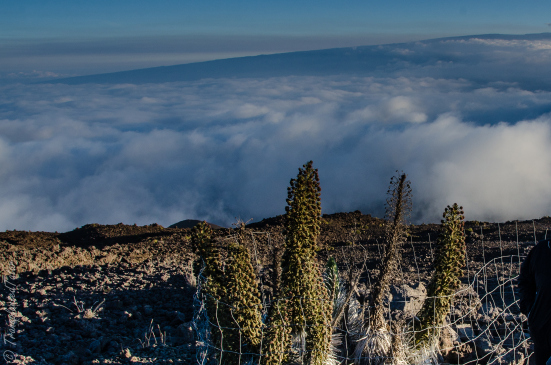
by Deep Green Resistance News Service | Jun 21, 2015 | Listening to the Land
By Will Falk / Deep Green Resistance
I went to the Thirty Meter Telescope construction site near the summit of Mauna Kea for the first time, today. Four-wheel drive is recommended for the road that twists steeply with hairpin turns up the Mountain, so ten of us piled into a Kanaka uncle’s (older native Hawaiian man’s) pick-up truck to go see the summit. Leaving from the visitor center parking lot at 9,200 feet the road ascends over 5,000 feet to an elevation close to 14,000. While my ears popped, my sense of wonder grew. Conversations around the truck bed stopped as the Mountain’s power over our senses intensified.
Beginning below the tree line, the six-mile ride carries you through ancient cooled lava flows, across red-stained cinder fields, and under patches of snow adorning Mauna Kea’s brown shoulders like jewels. When we parked we took a moment to breathe the air that is thin, but crisp and fresh. The walking was hard. We moved slowly and I wondered if Mauna Kea keeps the air thin on purpose to ensure peace on the slopes. Serenity filled the spaces where the hills parted to show the clouds carpeting the valley floor below.
I felt like I was traveling in a timeless land until we turned a corner on the trail and the thirteen existing telescopes appeared on the ridge lines forming Mauna Kea’s summit. My breath caught and my stomach soured.
Some are calling the collection of observatories and assorted buildings the “industrial park on Mauna Kea” and I understand why. The telescopes themselves are housed in blank, white geodesic domes. Numerous support buildings including giant satellite radar dishes dot the slopes leading up to the telescopes. Roads – both paved and simply graded – lacerate the mountainside. Brown and orange outhouses stand like sores in otherwise breath-taking cinder fields. I recalled a picture I saw down at the visitor center showing one of Mauna Kea’s hills being dynamited before construction. Scars are still visible years later.
We did not linger long and left down the trail for Lake Waiau. There is no mistaking the sacredness of Lake Waiau. The Lake’s waters are an emerald green in the center rimmed in royal blue as the waters approach the Lake’s red cinder banks. I sat engulfed in the shimmering waves on the Lake’s surface. The wind is alive on Mauna Kea and it seemed to sense the enormity of the experience for me, dying down to allow me my stillness.
Then, two uncles in our party blew long, clear blasts on conch horns. The echoes rang through the intimate valley where Lake Waiau sits and filled my chest with warmth. I began to cry.
One of the uncles brought a harmonica and played some soft blues to the breeze. I kept crying. I cried for the destruction on Mauna Kea’s summit. I cried for the pain Kanakas expressed to me and to each other while talking story at the occupation. I cried for the pure joy of experiencing a power humans have felt for millennia and will continue to feel so long as we stop the destruction of the world’s sacred places.
****************
Back at the occupation, I reflect on my first trip to Mauna Kea’s summit. Ahinahina, named silverswords in English, are blooming on the slopes of Mauna Kea. The fragrance of their purple flowers sweeten the dry mountain air. Their silver stems glisten in the wind and shimmer with the sunshine. Above the ahinahina, the gold flowers of the mamane trees dance with delight to the day’s colors. I close my eyes in an effort to print these images onto my heart. I imagine what Mauna Kea must have looked like a couple hundred years ago when Kanaka Maoli – aboriginal Hawaiians – treated these slopes as sacred and forbidden to all but the most holy activities. No cattle were allowed here then. No invasive species choked out the ahinahina and mamane forcing endemic species to within inches of their existence. I imagine the mountain sides as they must have been: awash in silver and gold.
Silver and gold. I wince at the irony. That is, after all, what the Thirty Meter Telescope project is all about – pieces of silver and mounds of gold.
I open my eyes again, asking silently for the words ahinahina and mamane might want me to write. I wish I could ponder the beauty of these endangered plants forever. As I think this, standing in front of a ahinahina mesmerized by her elfin colors, a sparkle grows deep in her thin leaves and the comparison to the twinkle of stars Mauna Kea is famous for is undeniable.
****************
Of course, there are those saying the Thirty Meter Telescope project is about something more noble than money. I’ve heard, for example, it’s for “pure human curiosity,” or for “love for the stars.” The problem with this is not all human curiosities, nor all loves are created equal.
Where have we heard the human curiosity argument before? It is often used to excuse the actions of explorers that open the lands of original peoples to colonization. Christopher Columbus has his own holiday for “discovering America” while the total eradication of the Taino people is forgotten. Hitting closer to a Hawaiian home, Captain James Cook is honored for supposedly being the first European to land in Hawai’i.
And what has this cost Hawai’i? The population of Hawai’i in the late 1770s is estimated at more than one million people. By 1897 at the time of the Ku’e Petitions, only 40,000 Hawaiians survived. Over 95% of the Hawaiian people died in 120 years due to contact with Europeans. Of course, Cook knew this would happen as he warned his sailors not to engage in intercourse with Hawaiians.
Some will excuse Cook saying at least he tried to control his sailors. But, when we’re talking about the near total extinction of a whole culture, I think we need to judge with stronger standards. Who goes to work when they have a communicable disease like a cold? Who goes to work when they have a potentially fatal communicable disease? Who, among us, would willingly and knowingly expose our loved ones to danger? Cook did, and he did it, in part, out of “human curiosity.”
In response to the “love for the stars” argument, keep in mind that the Ku Klux Klan advertises itself as a “love group not a hate group.” Either we have to trust people like the KKK, or we realize that we cannot trust everyone’s rhetoric. Another way to look at this is to understand that often what is called “love” in this dominant culture is really a poisoned version of what love truly is. Those responsible for the TMT project might love the stars, but that love is poisoned by the destruction their project will create. What is love if it causes you to violate boundaries established by aboriginal peoples? What is love if it causes you to clear an 8 acre space, digging two stories on a formerly pristine mountain top? What is love if it causes you to dangerously perch hazardous chemical waste above the largest freshwater aquifer on Hawai’i Island?
Now, I am certainly not saying that love for stars is wrong. Every night up here on Mauna Kea, I roll out my sleeping bag under the open sky and gaze in awe at the stars. There is a right way and a wrong way to love the stars. Hawaiians who loved the stars so much they were able to navigate the largest ocean in the world with handmade canoes using the naked human eye loved the stars the right way, the least invasive way, the most respectful way. The TMT project with all of its destructive technology, all of the waste produced by the materials used in its construction like steel, aluminum, and mercury, is loving the stars the wrong way.
The counter to my argument is often, “You say you love the Mountain, but what good is a mountain?” Thankfully, the brilliant professor of ecology and leading figure in the deep ecology movement, Neil Evernden, has come up with the best response. He says the best way to respond to the questions, “What good is a mountain? What good is a ahinahina? What good is a mamane tree?” is to ask “What good are you?”
Evernden’s point is something I learned looking at Lake Waiau, is something I learned listening to the ahinahinas and mamanes. Mountains, ahinahinas, mamanes, polar bears, rhinoceroses, and you and I each exist for our own subjective purposes. Ahinahinas have lives, joys, dances, and purposes as valuable to them as ours are to us.
To take this idea even deeper, I know when I heard the clear notes of the conch horns above Lake Waiau I was sharing in a tradition thousands of years old. When the winds blew through my hair, the pores of the cinder rocks mixed with the pores of my skin, and the blue light on Lake Waiau was reflected in the blue light in my eyes, I was engaged in relationships that made me most fully human. To block those winds, to dynamite those cinder rocks, to poison the light from Lake Waiau, will destroy the relationships that make humans human. In other words, destroying Mauna Kea is destroying ourselves.
From San Diego Free Press
Find an index of Will Falk’s “Protecting Mauna Kea” essays, plus other resources, at:
Deep Green Resistance Hawai’i: Protect Mauna Kea from the Thirty Meter Telescope
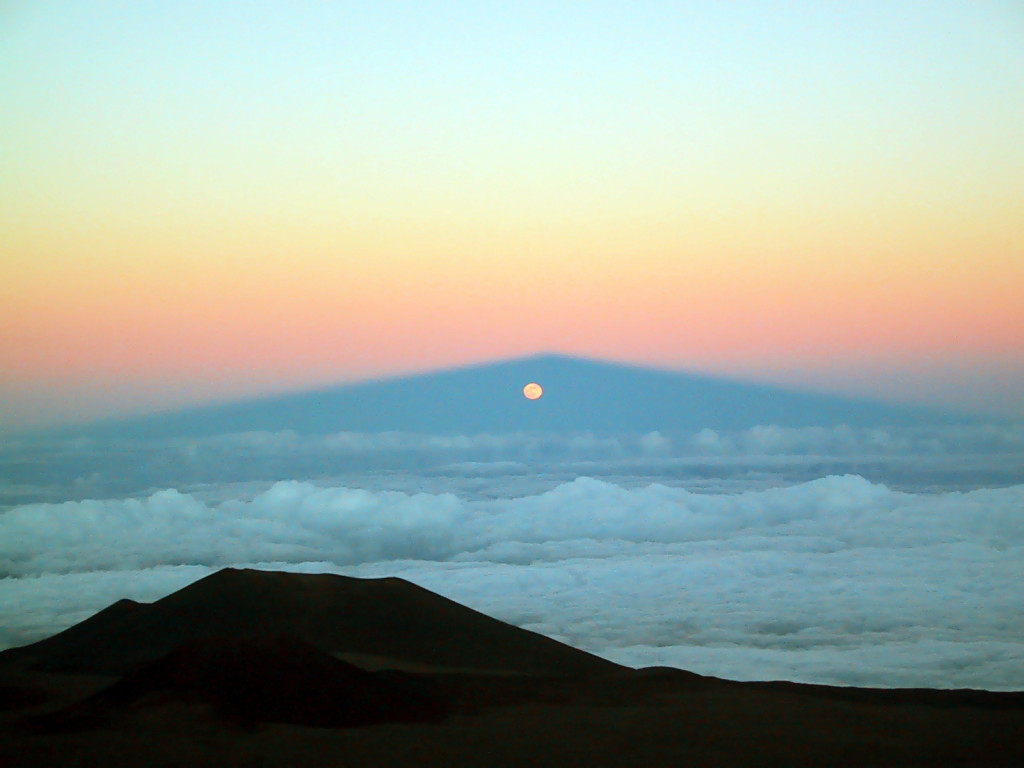
by Deep Green Resistance News Service | May 22, 2015 | Indigenous Autonomy, Listening to the Land
By Will Falk / Deep Green Resistance
Looking up at the still, lingering morning stars from the best stargazing location in the world early on the third day since my arrival at the occupation on Mauna Kea, my personal velocities catch up with me and I listen. I stand at 9,200 feet above sea level. North and above me, Mauna Kea’s shoulders broaden as they rise into the heavens. Down and to the east, a thick cover of clouds hides the valley below and deadens the rattle of rifle fire coming from the US military training center on the Mountain. Wind scatters the volcanic dust at my feet.
I have never been to a place like this, never looked down on the clouds from any where other than a plane seat, never marveled at the feel of lava pebbles in my palm and I wonder what it all means. Dawn’s thin air only offers my own reflections back to me.
I’ve been on the road for over a year now and the traveling leaves me feeling dizzy. After two suicide attempts, I decided to take tangible steps to alleviate my despair. A great part of my despair stemmed from the realization that life on Earth is running out of time. Even mainstream scientists are seriously questioning the ability of the human race to make it through the next half-century. Part of this destruction is rooted in the way the dominant culture has strayed too far from land-based, traditional knowledges. Traditional knowledges are often rooted in stories based on the land. So, one way to understand the destruction is to see how the dominant culture has forgotten the original stories the land is telling us.
My path out of despair has lead me all over this side of the world from the Unist’ot’en Camp on Wet’suwet’en territory in northern so-called British Columbia to Kumeyaay territory in so-called San Diego all the way across the ocean here to Hawai’i and Mauna Kea.
Moving at this pace, I sometimes feel profoundly lonely. Each new place means leaving friends behind and entering a social environment where no one knows who I am. My friends and family are scattered across North America. When I’d rather see my friends smile in person and hear their laughter transported over a breeze instead of the internet, I feel a deep sorrow. I know it is a self-imposed exile, but still, I yearn for home.
“Home” is something I do not have time for. The world is burning – our home is burning – and before I can rest comfortably in my home, I need to work to make sure that home does not burn down. Writing seems to be my talent, so I come to Mauna Kea persisting in my rejection of home, and offer up my pen.
Sitting down to write these first few days on Mauna Kea, to engage in the support I’ve promised, I’ve found that my migrations have an even deeper side effect: I struggle to relate to the places I’m in. New slants of sunshine are disorienting. New smells from a strange wind confuse me. I do not know the names of the birds I hear singing or the names of the trees who give me shade.
Writing is a spiritual practice for me that involves listening for the voices I know are speaking from the natural places I’m in. I’m finding it hard to understand what I am hearing here because I have not had enough time to develop relationships with the non-human beings living here on the Mountain. I have not heard enough of Hawaii’s history. I do not have the experiential referents to hear a story. I keep stumbling on the thought that I cannot possibly do this place justice in three days. Hawaiians have lived with Mauna Kea for time immemorial and already know what these other beings are saying.
Each time I try to describe a hill I’m looking at, the sound the sparse mountain trees make in the evening breeze, or the sight of the thin, new moon hanging low in the sky outside our tent, I sense much deeper stories at work. I feel incapable, unprepared, lost. I am not just seeing, hearing, and feeling these forces on a physical level. I sense these forces are working on a level deeper than I have the language to express.
How can I possibly write something comparable to the stories and wisdoms developed over millennia of listening by the original peoples who live here? Is English – a language developed in a land thousands of miles away – even adequate to the task? Or, am I struggling to articulate what I’m hearing because those voices are properly described in the Hawaiian language?
***
In these first three days, I have been showered in Hawaiian hospitality and my loneliness is alleviated. At the occupation, kapu aloha is thriving. I’ve spent most of my time “talking story” and I’ve learned just how potent Hawaiian traditional knowledges are. “Talking story” is a Hawaiian term meaning something similar to, but more than “chit-chat,” closer to “getting to know each other,” or “craic” in my own Irish tradition. Through talking story with the protectors here, I’ve heard about everything from the strategic military prowess of King Kamehameha I to the genius traditional navigational techniques of Hawaiian sailors to the high percentage of NFL players that come from Hawai’i.
Most importantly, though, I’ve been receiving an education in Hawaiian spirituality. I will not and cannot claim to know or understand very much of what has been shared with me. I’ve heard about the physical forms Hawaiian deities take – forms like snow, thunder, mist, and bamboo.
I’ve heard about Mauna Kea existing in both realms of the land and the sky and how traditionally humans were not supposed to travel very far up Mauna Kea. My experiences with death cause me to state that my favorite thing I’ve learned about Hawaiian spirituality, so far, is that every being that gives and facilitates life is a god revered for its role in supporting life.
Looking around me with my vision enhanced from the Mauna, I ponder life. The shallowness of my breath on the Mountain reminds me of those last moments before I lost consciousness each time I tried to kill myself. Both times I laid in what I thought would be my deathbed I was confronted with the shame knowing that suicide would prevent me forever from standing on the side of the living. Both times I saw the story of my life stretch out before me and knew I wanted the story to go on.
***
Last night while I was pondering my inability to write anything of substance, I experienced a series of significant events. First, while a few of us sat around talking story, the conversation turned to the Thirty Meter Telescope project. Stopping this project is, of course, why we’re here.
Many of the occupiers here are my age – I am 28 – and interestingly several of them were educated in Hawai’i’s first Hawaiian language immersion program. One of those who graduated from this program is a man named Kahookahi Kanuha, and I’ve heard him call the movement to protect Mauna Kea the most powerful Hawaiian movement since the resistance to American occupation in the 1890s. One of the reasons for the power of this movement, he explained, is that Hawaiians are getting their language back.
This fits what I understand about history. In my own Irish tradition, for example, the path to independence included a strong Gaelic language revival in the late 1890s with artists like William Butler Yeats and Lady Gregory creating new, specifically Gaelic works, with Gaelic language schools springing up around the nation, and a new academic interest in what had been an illegal language.
I know, too, that one of the first things colonizers do is work to erase the colonized’s language.
This happened in Hawai’i in 1896 when the illegal Republic of Hawai’i forbade the use of the Hawaiian language in schools. Indigenous languages are so important to decolonization because as Haunani-Kay Trask writes in her diagnosis of colonization in Hawai’i, “From a Native Daughter,” “Thinking in one’s own cultural referents leads to conceptualizing in one’s own world view, which, in turn, leads to disagreement with and eventual opposition to the dominant ideology.”
Later that night, after I heard Kahookahi explain that the Hawaiian language revival is empowering his people, the director of Hawai’i’s Department of Land and Natural Resources (DLNR) stopped by to talk story with the Mauna Kea protectors. In many respects, the DLNR’s interests are opposed to the Mauna Kea’s protectors, but he was invited in a spirit of dialogue and respect, and to his credit he visited (and brought us desert). During the course of the conversation, the director said, “There is fear in misunderstanding. And when you learn to understand, you learn not to fear.”
***
I am writing this Protecting Mauna Kea series, in part, to understand how it is possible for a culture to think it is acceptable to desecrate another people’s most sacred site by building a massive telescope on the top of a beautiful mountain. I want to understand what the individual humans responsible for this project think and feel. Are they simply mistaken about the nature of physical reality? Do they really think that digging deeply into a mountain to build a telescope will be harmless? What I have learned, so far on the Mountain, from the protectors, from Kahookahi, and from the director of the DLNR provide, perhaps, an answer.
Quite simply, when you understand a place is full of stories and the beings who provide these living stories, it becomes very difficult for you to destroy those stories. When you understand the language of a place and learn how to communicate in that place, it becomes very difficult for you to destroy that place. When you learn to talk story wherever you are, you can learn to understand, and fear becomes more difficult.
I think the TMT project is the result of a culture that has forgotten how to talk story, has forgotten the living stories unfolding everywhere around us. When you look at Mauna Kea and see a simple mountain – just a collection of earth as I’ve heard some insensitive folks describe it-you will treat it one way, but when you look at Mauna Kea and see, as traditional Hawaiians do, a vast collection of stories and living story-givers, you will treat it in a much different way.
Maybe the TMT project is a symptom of a culture moving too fast, governments spreading too far from the lands that created them, and peoples alienated from the homes of their ancestors?
Maybe the dominant culture is caught in the same problems I face in my travels? Moving with too high a velocity, it is confused, it is lonely, and instead of talking story with Mauna Kea, it seeks answers in the stars.
I have taken a great amount of comfort in the willingness of the Mauna Kea protectors to talk story with me. I am beginning to feel like I am making good friends. They are quick with inclusive stories and jokes. They are sharing the stories of Mauna Kea and my loneliness subsides.
All credit for this is due to the Mauna Kea Protectors.
I believe those controlling the TMT project have lost their stories and suffer a deep trauma because of this. They have forgotten that the land is the source of all meaning and feel justified destroying the land to build an attempt to find meaning on other planets. I think they would do well to truly talk story from a position of respect with the Mauna Kea Protectors. You never know what you’ll learn.
From San Diego Free Press
Find an index of Will Falk’s “Protecting Mauna Kea” essays, plus other resources, at:
Deep Green Resistance Hawai’i: Protect Mauna Kea from the Thirty Meter Telescope
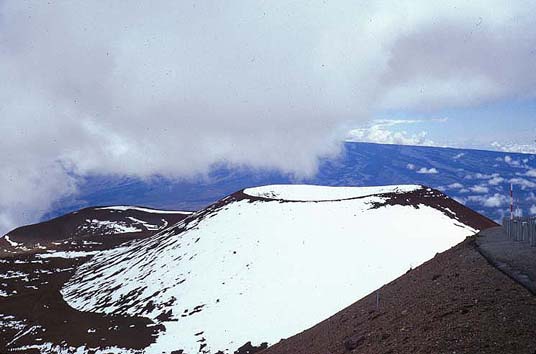
by Deep Green Resistance News Service | May 5, 2015 | Indigenous Autonomy
By Will Falk / Deep Green Resistance
When people have asked me why I am going to Hawai’i to help protect Mauna Kea and my answer involves words like “sacredness” or “spiritual,” I am surprised whenever I see the grimaces.
I often get an explanation like this, “I support indigenous people, of course, but the telescope is for science. Isn’t it a little…superstitious to block an astronomy project for a mountain?” I said I was surprised, but I shouldn’t be. Spirituality, I forgot, is anathema in many leftist circles.
It shouldn’t be.
I understand that many in this culture have been wounded by their experiences with religion. Some religions have, on the whole, been disasters for the living world. But, to write off all spirituality because of the actions of a few religions, is not just intellectually lazy and historically inaccurate, it erases the majority of human cultures that lived as true members acting in mutual relationship with their natural communities.
I am writing this article from occupied Ohlone territory in what is now called San Ramon, CA (in the Bay Area). According to the first European explorers who arrived here, this place was a paradise.
A French sea captain, la Perouse, wrote, for example, “There is not any country in the world which more abounds in fish and game of every description.” Flocks of geese, ducks, and other seabirds were so numerous that a gun shot would cause the birds to rise, “in a dense cloud with noise like that of a hurricane.”
In 250 years, with the arrival of Europeans and their spiritualities, we have gone from flocks of birds making noises like a hurricane to the concrete jungles many of us call “home.”
What was it about the Ohlone people that caused them to live in such balance with their natural community? Why didn’t the Ohlone people exhaust their land bases, over shoot the carrying capacity of their home, and colonize other lands like the Europeans who came with their crosses held high forcing the Ohlone to work and to die in the Missions? Only a racist could say, “Because they weren’t smart enough.”
Let me suggest that it was the Ohlone spirituality, the Ohlone way of relating to the world, that caused them to live the way they did. Of course, the Ohlone are just one of thousands of indigenous examples.
Right now, with the world on the verge of total collapse, wouldn’t we do well to respect the wisdoms developed by indigenous peoples who lived in balance with their land bases for thousands of years?
***
Those attempting to force the TMT project on Mauna Kea are products of a culture that has committed spiritual suicide. The dominant culture committed spiritual suicide when it adopted the belief that the land – as the physical source of all life – is not sacred.
Now, it attempts real suicide. I know because I did it, too. Twice.
The path to suicide begins with lies – lies like the notion that a mountain like Mauna Kea does not and cannot speak. As Derrick Jensen points out in A Language Older Than Words, the first thing they do in vivisection labs is cut the vocal cords of the animals they’re going to torture so they don’t have to hear the animals’ screams.
Now the dominant culture is cutting the vocal cords of the entire planet. Women are objectified so they may be raped, indigenous peoples are called savages so they may be massacred, and mountains are described as piles of matter so their tops may be chopped off, their guts ripped out in open pit mines, and massive telescopes built on their peaks.
The Sioux lawyer and author, Vine Deloria Jr., in his work God is Red, diagnosed our current environmental disaster as essentially a spiritual failure.
For Deloria, the Western notion that spirituality can be transported across space, time, and cultural context is a lie and leads to the spiritual emptiness that European settlers on this continent display.
Even worse, though, dominant Western spiritualities like Christianity demand that believers place their faith in a God existing somehow above and beyond the real, physical world. Instead of a belief in the land as the source of all life, an abstract, jealous, invisible, and largely incomprehensible male deity becomes the source of all life.
A hierarchy of beings is established with God on top, followed by angels, humans, animals comparable to humans evolutionarily, all the way down to plants, insect, and microbes. Mountains like Mauna Kea, in this view, are simple heaps of dirt. They may be pretty to look at, but nothing more.
My personal path to suicide reflects the cultural path to suicide Jensen and Deloria describe.
My family is devoutly Catholic. Before I turned 18 and left home, I can count the number of times I missed Mass on one hand. One of my grandmother’s favorite Christmas gifts was handmade, specially blessed rosaries. She says the rosary every morning. Scapulars hang from the rearview mirrors of cars family members drive. Of course, every doorway contains artistic renditions of Christ’s crucifixion.
I remember sometime in my early teens standing beneath a particularly brutal crucifix when I recognized the spiritual emptiness surrounding me. I looked at the crown of thorns piercing Christ’s forehead. I watched the blood running into his eyes. I winced at the spikes driven through his hands and feet. I knew that Christ’s femurs were broken by soldiers – mercifully, perhaps – so he could not use his legs to push up, open his lungs, and draw breath. I grew nauseous imagining Doubtful Thomas digging his hands into the lance wound under Christ’s rib cage.
Educated in Catholic grade schools, I knew the various explanations for Christ’s terrible death. He died to fulfill Old Testament prophesies. He died to redeem humanity. He died because he brought a revolutionary message of humility, poverty, and love. He died because he challenged the power of his Roman and Jewish rulers. He died, simply, to save the world.
I began to think about the spiritual practices in the Catholics I knew. I didn’t know anyone who was giving up much more than a percentage of their income to the Church much less putting their lives in danger to save the world.
When I asked myself how so many people could insist that Catholicism was the one, true faith while no one was willing to walk the same paths as Christ, the first cracks appeared in the wall of denial I called “faith.” Simply put, I looked around and couldn’t find any Christs.
As I grew up, the wall crumbled. The first time I masturbated I was convinced the Virgin Mary would appear to haunt me. The day after I lost my virginity, I went to Mass expecting to feel God biting me with guilt. All I could feel was joy that I could share such a wonderful feeling with a lover. I finally allowed myself to accept my disbelief and started asking questions. How could people professing love for the world propagate a message rooted in guilt, self-denial, and shame?
I became angry. I felt completely betrayed. I saw a world filled with spiritually dead people. The only people I knew speaking about spirituality were liars. So, I took my anger too far and decided that spirituality itself must be dead.
Giving up on spirituality, the world became a dead zone filled simply with material. Yes, I worked to ease human suffering. But, I only did this out of a strange sense of duty, out of the remnants of Catholic guilt that seeped so thoroughly into my soul that I knew no other way to function.
I hung on to this perspective for a few years, denying the voices singing around me, and essentially strangling my own spirituality to death. The dominant culture is cutting vocal cords and I stuffed my ears with despair. Perhaps, it was only logical – committing spiritual suicide as I did – that physical suicide came next.
***
The TMT project on Mauna Kea and others like it around the world are expressions of a culture determined to commit suicide. And I’m not talking about a metaphoric, cultural suicide. I’m talking real, physical suicide. I’m talking about the destruction of the planet’s life support systems.
How else do you explain storing a 5,000 gallon hazardous chemical waste container above the largest freshwater aquifer on Hawai’i Island like the TMT builders want to do?
To stop the TMT project, to stop the genocide of indigenous peoples, and to save the world, I believe we need to empower spiritualities that learned how to live in balance with their land bases. We need to empower indigenous spiritualities around the world.
Our predicament today is even more dire than in 1973 when Deloria wrote in God Is Red, “Ecologists project a world crisis of severe intensity within our lifetime…It is becoming increasingly apparent that we shall not have the benefits of this world for much longer. The imminent and expected destruction of the life cycle of world ecology can be prevented by a radical shift in outlook from our present naive conception of this world as a testing ground of abstract morality to a more mature view of the universe as a comprehensive matrix of life forms. Making this shift in viewpoint is essentially religious, not economic or political.”
I need to be absolutely clear before I write on: Personal spiritual transformation is not going to save us from anything, but our own personal despair. What we need are spiritual transformations on the cultural scale, but we’re not going to achieve these transformations when too many insist that spirituality is worthless.
Just like we will not recycle our way to the revolution, successfully petition Shell to stop murdering the Niger River Delta, or write a persuasive enough essay to convince those in power to stop the TMT project, personal spiritual transformation is too often a distraction from the need for physical action in the physical world.
I’ve written that no emotion – including despair – can kill you. You can kill you. You can put a gun to your temple, snort up a bottle of pills, or run the exhaust into your sealed-off car, and kill yourself. But, in each instance it will not be an emotional or a spiritual state that will kill you. It will be a physical action that kills you. This also means that it will take physical actions to bring you out of despair. This is as true on the cultural level as it is on the personal.
The dominant culture suffers from a profound sense of despair. It says that destruction is human nature. It says that greed is universal. It says that we already live in the best possible world and this world is violent, evil, and hateful. It would be one thing if the dominant culture was content to hold this despair in its heart, content to stay in bed all day with the paralyzing despair that many of us have felt.
The problem for life on this planet – the problem at Mauna Kea – is the dominant culture manifests its despair physically. Once the dominant culture isolated itself from the rest of life, it grew resentful. It became angry. And now it seeks a murder suicide. Left unchecked, it will kill everything and then turn the gun on itself.
In order to turn the spiritual tide we must protect places like Mauna Kea. If we lose the sacred, we won’t be far behind.
From San Diego Free Press
Find an index of Will Falk’s “Protecting Mauna Kea” essays, plus other resources, at:
Deep Green Resistance Hawai’i: Protect Mauna Kea from the Thirty Meter Telescope













